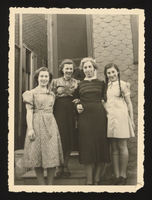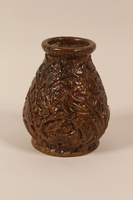Overview
- Brief Narrative
- Large, intricately designed camelback trunk used by 13 year old Edith Simon when she, her parents, Willy and Greta, and her sisters, Lotte and Gerda, emigrated from Leipzig, Germany, to the United States in 1937. The trunk was originally owned by Edith's grandmother, Hedwig Maerker, who was killed in Theresienstadt concentration camp during the Holocaust.
- Date
-
emigration:
1937
manufacture: 1880
- Geography
-
use:
Leipzig (Germany)
- Credit Line
- United States Holocaust Memorial Museum Collection, Gift of Ellen, Erin, and Mark Rosenthal
- Markings
- on the slat brackets : 1880 / MAR / PAT.
- Contributor
-
Subject:
Edith Rosenthal
- Biography
-
Edith Simon (1923-2009) was born on February 26, 1923, in Leipzig, Germany, to William and Margaret (Grete) Maerker Simon. Grete’s parents were Louis and Hedwig Weil Maerker. Edith had two sisters, Lotte, born in 1925, and Gerda, born in 1921. Grete and Willy married in Bernburg and settled in Leipzig where Willy operated a prosperous real estate and mortgage business. His business did well even during the difficult economic conditions of the 1920s. But after Hitler’s rise to power in 1933 with the growing persecution of Jews and boycotts of their businesses, her father's business began to fail. The family left Germany for the United States in 1937 and settled in Philadelphia. She married Harry Rosenthal and they had two children. Many family members were deported to Theresienstadt and other concentration camps where they were killed.
Physical Details
- Classification
-
Containers
- Category
-
Luggage
- Object Type
-
Trunks (Luggage) (lcsh)
- Physical Description
- Wooden camelback trunk with a peaked, convex lid with black metal sheets at the opening and sides. The frame is covered in gold colored, tin sheets embossed with leaves and grape vines, with black metal sheets on the corners. A horizontal wood slat surrounds the entire trunk near the bottom, with gold colored decorative metal clamps at the corners. On the front, 5 vertical wood slats ascend from the horizontal slat. There is a central wood slat around 3 sides of the trunk, attached with gold colored metal clamps on the corners. A leather handle is attached with 2 gold metal end caps. The underside has 3 wood slats and black metal sheeting, with a small gold colored wheel attached with a decorative clamp at each corner. There are decorative gold clamps on the trunk corners and sides. The lid attaches to the base by 4 black metal strap hinges. A leather handle is riveted to the front; beneath is a decorative embossed black metal trunk lock and 2 gold decorative trunk catches. The interior is lined with red and black paper. The top of the short sides has 2 wood rails for a tray. The right side has a black metal lid support; the lid has a silver tray latch and a wood divider, with a paper liner on the smaller right side, and a lithograph image of a girl in a bonnet holding a cat surrounded by leaves and flowers.
- Dimensions
- overall: Height: 31.750 inches (80.645 cm) | Width: 38.625 inches (98.108 cm) | Depth: 22.125 inches (56.198 cm)
- Materials
- overall : wood, metal, leather, paper
Rights & Restrictions
- Conditions on Access
- No restrictions on access
- Conditions on Use
- No restrictions on use
Keywords & Subjects
Administrative Notes
- Legal Status
- Permanent Collection
- Provenance
- The steamer trunk was donated to the United States Holocaust Memorial Museum in 2005 by Mark, Ellen, and Erin Rosenthal, the son, the daughter-in-law, and granddaughter of Edith Simon Rosenthal.
- Record last modified:
- 2022-07-28 18:11:19
- This page:
- https://collections.ushmm.org/search/catalog/irn518094
Download & Licensing
In-Person Research
- By Appointment
- Request 21 Days in Advance of Visit
- Plan a Research Visit
- Request to See This Object
Contact Us
Also in Edith Simon Rosenthal collection
The collection consists of artifacts, documents, and a photograph album relating to the experiences of Edith Simon Rosenthal and her family in Leipzig, Germany, prior to their emigration to the United States in 1937.
Date: 1920-1937

Edith Simon Rosenthal papers
Document
The collection includes a family photograph album and Edith Simon Rosenthal's birth, vaccination, and naturalization certificates documenting the lives of the Simon family from Leipzig, Germany before World War II and their immigration to the United States.

Handthrown ceramic vase with relief design of birds used by a German Jewish refugee family
Object
Vase brought in a steamer trunk by 13 year old Edith Simon when she, her parents, Willy and Greta, and her sisters, Lotte and Gerda, emigrated from Leipzig, Germany, to the United States in 1937. The vase was a family heirloom, orignally owned by Hedwig Maerker, Edith's grandmother, who was killed in Theresienstadt concentration camp in 1942.
Floral and lion patterned needlepoint table covering saved by a German Jewish refugee family
Object
Bed or table covering brought in a steamer trunk by 13 year old Edith Simon when she, her parents, Willy and Greta, and her sisters, Lotte and Gerda, emigrated from Leipzig, Germany, to the United States in 1937. The needlepoint covering was made in the early years of the 20th century by Hedwig Maerker, Edith's grandmother, who was killed in Theresienstadt concentration camp during the Holocaust.



